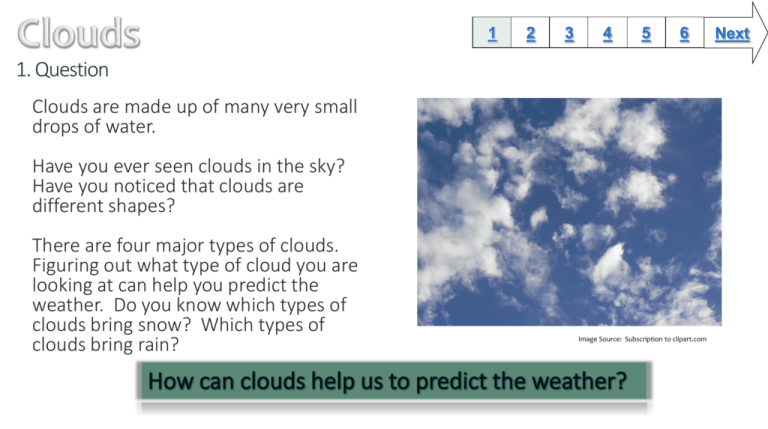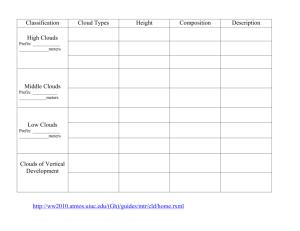
1
2
3
4
5
6
1. Question
Clouds are made up of many very small
drops of water.
Have you ever seen clouds in the sky?
Have you noticed that clouds are
different shapes?
There are four major types of clouds.
Figuring out what type of cloud you are
looking at can help you predict the
weather. Do you know which types of
clouds bring snow? Which types of
clouds bring rain?
Image Source: Subscription to clipart.com
Next
2. Information Sources
1
2
3
4
5
6
Next
Types of Clouds
pebblego.com
What Are Clouds?
pebblego.com
Cumulus
Image Source: Subscription to pebblego.com
Cirrus
Stratus
Nimbus
3. Student Activity
1
Pick a type of cloud you would like to
recreate.
You will need to reread the information
about your topic and take notes.
Include a picture of your cloud and what type
of weather it predicts in the note-taking
sheet.
You will also need to complete a visual search
in Destiny to locate books on clouds in our
school library.
Image Source: Subscription to Destiny.
2
3
4
5
6
Next
Search for books
about clouds!
4. Assessment Activity
1
2
3
4
You will now create the cloud
you have researched. Use
cotton balls to form the cloud.
Complete the sentence starter
and attach it to your finished
cloud creation.
Image Source: en.wikipedia.org
5
6
Next
5. Enrichment Activities
1
Video on cloud formation
3
4
5
Image Source: pbskids.com
Tim and
Moby share
information
on clouds
Image Source:
Subscription to Brain Pop Jr.
Magic
School
BusKicks Up
a Storm
*NOTE: Go to the BCPS Database page and
click on BrainPOP, then return to this slide
and click on the video link above.
Image Source: pbskids.com
6
Super Lab Fun
Image Source: Subscription to Destiny
Weather Transformer
2
Image Source: Subscription to Safari Montage
Next
6. Teacher Support Materials
First grade and Library Media
BCPS Curriculum / Maryland State Curriculum
1.0 Skills and Processes. Students will demonstrate the thinking and acting inherent in the practice of science.
A.1. Raise questions about the world around them and be willing to seek answers to some of them by making
careful observations and trying things out. b. Seek information through reading, observation, exploration, and
investigations.
Common Core State Standards
C.C.1.R1.1.5 Know and use various text features (e.g., headings, tables of contents, glossaries, electronic
menus, icons) to locate key facts or information in a text.
C.C.1.R.1.1.6.Distinguish between information provided by pictures or other illustrations and information
provided by the words in a text.
C.C.1.R.1.1.7 Use the illustrations and details in a text to describe its key ideas.
C.C.1.R.1.1.10 With prompting and support, read informational texts appropriately complex for grade 1.
Standards for the 21st Century Learner
1.1.1 Follow an inquiry-based process in seeking knowledge in curricular subjects, and make the real-world
connection for using this process in own life.
1.1.2 Use prior and background knowledge as context for new learning.
1.1.6 Read, view, and listen for information presented in any format (e.g. textual, visual, media, digital) in
order to make inferences and gather meaning.
1.1.8 Demonstrate mastery of technology tools for accessing information and pursuing inquiry.
2.1.1 Continue an inquiry-based research process by applying critical-thinking skills (analysis, synthesis,
evaluation, organization) to information and knowledge in order to construct new understandings, draw
conclusions, and create new knowledge.
2.1.3 Use strategies to draw conclusions from information and apply knowledge to curricular areas, real-world
situations, and further investigations.
ISTE NETS - National Educational Technology Standards for Students
3. Research and information fluency. Students apply digital tools to gather, evaluate, and use information. d.
Process data and report results
1
2
3
4
5
6
Time Frame: 3 50 minute lessons
Differentiation strategies for this lesson: This slam dunk will need direct
instruction in various points of the lesson. Students may need
assistance in logging in to various websites. Some students may
be able to complete the activities independently.
Learning Styles addressed in this lesson: Visual, Logical, Auditory, Tactile
and Kinesthetic.
Notes to the teacher:
Slide 2- Students will need log in information for pebblego.com. Once
at the sight they will need to search weather and then they will click on
What are Clouds? The students will then need to view Types of Clouds.
The students can then narrow down their search and reread/research
the type of cloud they are interested in.
Slide 3- Students will need a paper copy of the Cloud Fact Sheet in
order to record what they have leaned about their cloud. Assistance
will be needed to search in Destiny for additional cloud books.
Slide 4- Blue construction paper, cotton balls and glue will be needed
for students to complete their cloud replication. Students will need a
paper copy of the sentence starter to complete.
Slide 5- Students may need to log on to brain pop and safari montage.
Weather Information and Super Lab Fun are located at PBS Kids.
Last updated: July, 2015
Created by Brenda Chamberlain, Library Media Specialist Intern
BCPS Slam Dunk Research Model, Copyright 2013, Baltimore County Public Schools, MD, all rights reserved. The models may be used for educational, non-profit school use only.
All other uses, transmissions, and duplications are prohibited unless permission is granted expressly. This lesson is based on Jamie McKenzie’s Slam Dunk Lesson module.









